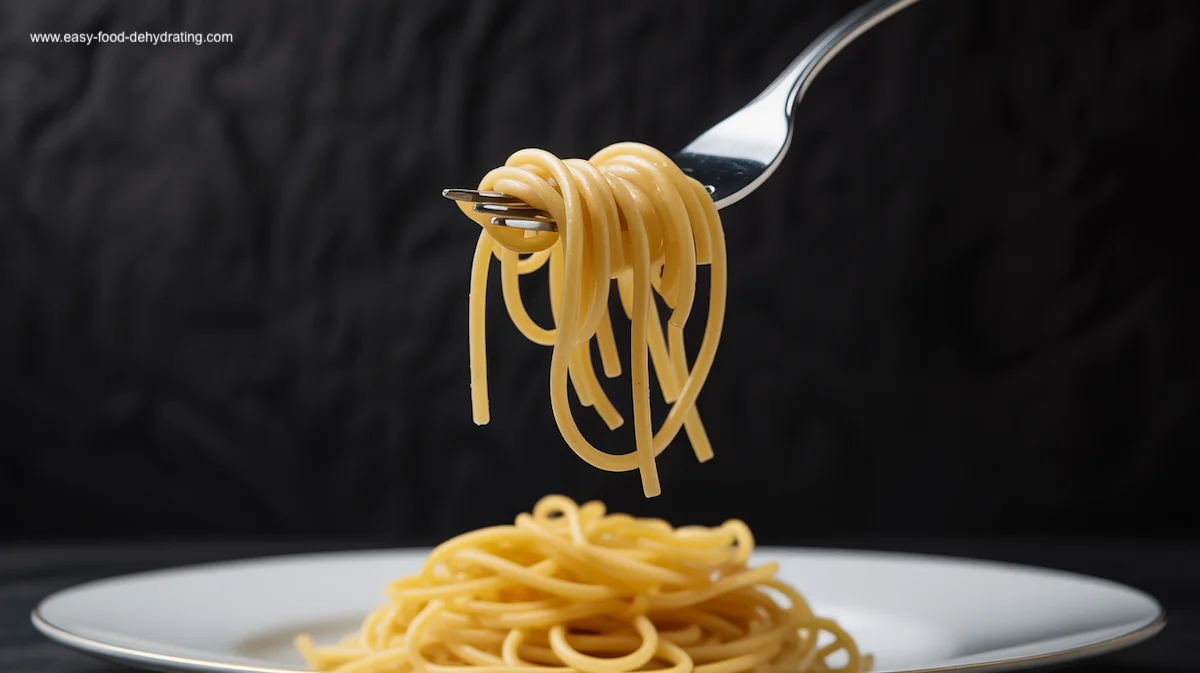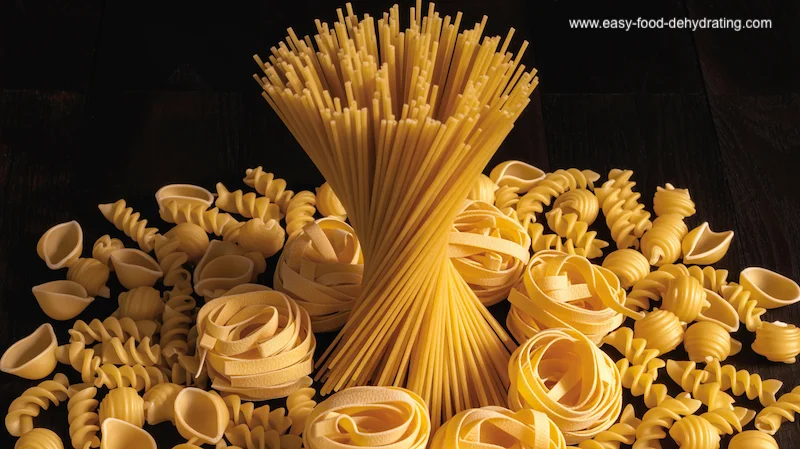What We Mean by “Dehydrate”
Here at Easy Food Dehydrating, “dehydrate” always means using an electric food dehydrator — the easy, reliable way to dry food at home.
- Home
- Rehydrating Pasta: Faster Meals with Less Water and Energy
Rehydrating Pasta for Faster Meals
and Emergency Prep
Pasta is a comfort food staple, but what if you could make it cook faster and use less water—perfect for camping trips, busy nights, or emergencies? That’s where rehydrating pasta comes in. By cooking, dehydrating, and later rehydrating pasta, you can enjoy satisfying meals with less fuel and water.
✅ Quick Answer: Can you rehydrate pasta after dehydrating it?
Yes. Cooked pasta can be dehydrated, stored, and later rehydrated by adding boiling water and letting it sit covered for about 15–20 minutes. It won’t always save cooking time, but it can reduce water use and simplify meal prep for camping, emergencies, or make-ahead meals.
Guest contributor Lori from Illinois put this idea to the test, experimenting with different pasta shapes and drying methods. Her results show what works, what doesn’t, and when this hack really pays off.

Why Bother Rehydrating Pasta? The Surprising Benefits
Laura continued: "By that I mean in certain emergency situations, wouldn't food prep be faster and use less water if pasta (noodles, spaghetti, etc.) were also cooked, then dehydrated and packaged for long-term storage?
'Instant' rice comes to mind as an example of a product already on store shelves (albeit they're in short-term packaging).
Any prohibitions to adding pasta products? Any special considerations in preparing - packaging - storing?," asked Lori.
Lori said she would cook some pasta, let it sit after vacuum-packing, and then rehydrate/cook it again:
"Today I cooked my previously-cooked-and-dehydrated al-dente
pasta and it took just about the same amount of cooking time in boiling
water ... so unfortunately, I can't see any benefit to dehydrating
cooked pasta to save energy resources, sadly!" Lori said.
Testing Pasta Dehydration at Home: Lori’s Results
Lori was supposed to be going out of town for a few weeks but wrote back with this: "I never made my trip out of town, an ear infection got in the way so while stranded at home I did dehydrate three different kinds of pasta, elbow macaroni, wide noodles, and the small mostaccioli.
My dehydrator dried each of the three types in about 3 hours.
I experimented with two temperature settings, one at 150 degrees (suggested by a backpacker) and the other at 135 degrees. Both turned out about the same, needing about 3 hours.
The wide noodles were a thicker specialty brand, not the thin flat noodles, which I did at the higher temperature."
Lori is using Nesco's newest Gardenmaster FD-1018P, a 1000-watt dehydrator that has a faster drying time. It will handle up to 30 trays.
Lori continues, "People who may try this at home using other makes and
models
may find their drying times are longer."
What’s the Best Way to Rehydrate Pasta?
Lori said: "Let me have some time tomorrow to experiment."
She continued to search online after her initial contact with me and discovered backpack/hiking websites where the food discussion threads were very helpful.
"Rehydrating pasta may take about the same amount of time, but as I
recall, the backpacking board discussions pro vs con did point out that when rehydrating pasta, less water was needed as
opposed to when the pasta was originally cooked," Lori shared.
She noted that when cooking, if too little water is used, then you see problems with the water getting starchy and the noodles sticking together.
"Maybe the real benefit and savings to rehydrating pasta is with water usage and not fuel consumption. In a particular scenario—like people hiking or camping and to all those people out east after the hurricane and now have no electricity and their drinking water may be questionable and difficult to acquire—potable water resources could be an issue.
I'm guessing that the investment in dehydrating cooked pasta will have value for the weekend warrior or casualties of mother nature—people whose need is outside the box of the typical money-saving homemaker," Lori added.
Does Rehydrated Pasta Taste Like Fresh?
Lori says: "I just finished my first reconstitution test!"
Step-by-Step: How to Rehydrate Macaroni the Easy Way
"I put 1 cup of dehydrated macaroni into a small stainless steel bowl, then poured 1 cup of boiling water over the pasta, and covered the top of the bowl with a small plate to keep the heat and steam enclosed.
Maybe next time I'll add a towel around the whole deal for added heat retention.
I set a kitchen timer for 20 minutes, figuring it might take a tad longer to rehydrate since the water was no longer boiling.
I removed the top 3-4 times to give the pasta a stir and make sure the macaroni had sufficient water available for maximum absorption.
Maybe that was unnecessary after the initial 'pour, stir, and cover'. It's just what I did out of curiosity because it was the first time I attempted this.
After 10 minutes, the pasta had that 'cooked look' and at 7 minutes left I had to taste test and would say the macaroni was at the al dente stage. I let the remaining time run out.
The stainless
steel bowl, of course, had cooled down some, but was easy to handle.
The pasta was softer and more like what everyone is used to. I poured
out the remaining water and ended up with 1/3 cup of slightly cloudy
water," Lori noticed.
Why Rehydrated Pasta Works Better Than You Think
"I only needed to boil 1 cup of water for my 1 cup of small macaroni pasta, with a small amount of water left over. Less energy consumption, a fraction of the water to finish it off, and then a 20-minute or so wait.
So the hiker/backpacker has something going there and people stuck in a disaster situation can put food on the table faster and not squander their fresh drinking water, which mostly gets thrown away if cooking using conventional methods.
Additionally, the hikers also will use the zipper-style freezer
bags to reconstitute their dehydrated meals. No pots and pans! After
adding water, they can put their baggie into something called a 'Cozy'
(typically a quilted cloth pocket) which insulates the cooking food
until ready to eat," Lori said.
 Courtesy of Camtasia - Registered User
Courtesy of Camtasia - Registered UserWide Noodles & Mostaccioli: Rehydration Test Results
"I measured out 1 cup each of the pasta. The noodles I snapped in half so as to get a full cup of pasta. I found smaller stainless bowls of the same size and put each on a pot holder, and found some thicker terry kitchen dish towels to wrap (insulate) after the water was added.
I added 1 cup boiling water to each bowl, gave a good stir, and covered the bowl top with a hard plastic cutting board. A towel was wrapped around the two adjacent bowls and two more were placed on top of the cutting board ... so it was pretty hard for the heat to escape!
Twenty and more minutes later (I got wrapped up in an episode of "Picker Sisters" on Lifetime ...oops!) I checked on the bowls. They were pretty much done and did need a little more stirring to separate some 'stick-together clumps'.
Again, when draining off the excess there was about 1/3 cup of water from each bowl. The noodles are perfect and ready for use.
Think 'cool kitchen' in August, with little or no added humidity from pots of boiling water, and the AC not running more because of the added heat! So there is an energy savings of sorts.
Hope my slightly different process of reconstituting and preparing will have some value to some of your readers," Lori concluded.
Thank You, Lori, for sharing your faster pasta prep regarding rehydrating pasta with us!
Rehydrated Spaghetti Bolognese: A Make-Ahead Win
Nick wrote to us from Wales, UK, and wanted to let us know of his 'experiment' with Spaghetti Bolognese.
This is what he said: "Cooked up my own spaghetti bol this week, combining the pasta & sauce and standing overnight to allow the pasta to absorb the sauce before dehydrating.
Once dry and brittle, I put a large portion in a wide neck 1-ltr vacuum food flask, added boiling water to just about cover it, and added the fitted lid. Hey presto! Packed lunch at work eaten directly from flask... experiment successful.
The flask is feather light, virtually unbreakable, and costs very little at the local cheap-goods shop. The food was hot and just about the right sauciness without pouring anything off!"
Great idea Nick! Thanks very much for sending this in. :-)
FAQs About Rehydrating Pasta (and Making It Work for You)
Does dehydrated pasta cook faster when rehydrated?
Does dehydrated pasta cook faster when rehydrated?
Not always. Most pasta still needs 15–20 minutes to rehydrate in hot water, but it typically requires less fuel and less water than boiling raw pasta.
What types of pasta work best for dehydrating and rehydrating?
What types of pasta work best for dehydrating and rehydrating?
Small shapes like macaroni, rotini, or mostaccioli tend to rehydrate more evenly than thick or wide noodles. Breaking pasta into smaller pieces also speeds up absorption.
Can I dehydrate pasta with sauce already on it?
Can I dehydrate pasta with sauce already on it?
Yes! Make-ahead meals like spaghetti Bolognese dehydrate well. When rehydrated, the pasta absorbs the sauce, creating a ready-to-eat, one-pot meal with no draining required.
Lori and I hope you enjoyed reading rehydrating pasta! Read more about rehydrating food here.
Rehydrating pasta may not replace your usual stovetop routine, but it’s a clever trick when you need to conserve water, cut down on cooking gear, or prepare meals ahead of time.
And if you’d like more inspiration for tasty dried meals, don’t forget to grab your free 5 Dried Food Recipes You'll Actually Love PDF below—featuring carrot soup, minestrone, split pea soup, spicy beef jerky, and even banana cinnamon rolls. They’re all simple, satisfying, and perfect for your pantry.
Get 5 Dried Food Recipes You'll Actually Love
Here's where you can get your copy of our all new
5 Dried Food Recipes (That Actually Taste Great)
They're my all-time favorite easy dried food meals!
Get it here right now.
For Free!
Before You Go...
If you enjoyed this page, tap the ❤️ in the lower right-hand corner.
It saves this page to your Grow bookmarks so you can find it again later.
You’ll also see quick share buttons to copy the link, post to Facebook,
or save it straight to Pinterest.
















